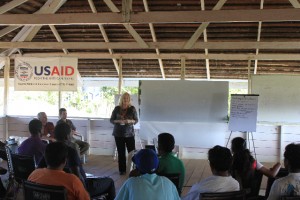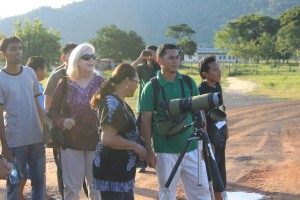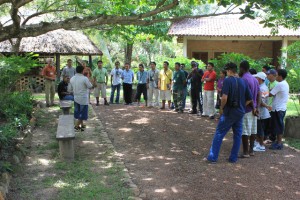
NORTH RUPUNUNI, Guyana – From Georgetown in the north to Dadanawa in the South, 23 tour guides from around Guyana are currently attending the Interpretive Guide Training Program from July 2-15, 2011. The course is being sponsored and organized by the Guyana Sustainable Tourism Initiative, a joint project of the United States Agency for International Development/ Guyana Trade and Investment Support (USAID/GTIS) Project and the Guyana Tourism Authority (GTA).
The course is taking place at several locations in Guyana’s North Rupununi, including the Bina Hill Institute, Rock View Lodge, Atta Rainforest Lodge and Iwokrama Canopy Walkway, and Surama Village and Eco-Lodge.
To ensure that the training program is a nationwide initiative, tourism lodges, community tourism projects and tourism organizations from around Guyana were invited to send one of their lead guides to participate. The guides that are receiving the training will then be responsible for sharing the knowledge and skills that they learn on the course with fellow staff at their home site.
A combination of local experts and an interpretive instructor from the United States are teaching the course. Guyanese instructors contributing to the program include professional tour guides Ron Allicock and Wally Prince; Sydney Allicock of Surama Village and Eco-Lodge; Teri O’Brien of Wilderness Explorers; Hugo Panti and Raquel Thomas-Caesar of the Iwokrama International Centre; and Jennifer Wishart of the Walter Roth Museum.
The lead instructor is Chuck Lennox, Principal of Cascade Interpretive Consulting LLC. Chuck brings 25 years of professional experience to the training program and is an expert in developing quality interpretive and education programs, training programs, natural history and wildlife classes.
GUIDE TRAINING
The training course has been designed to build upon and improve the guides’ existing knowledge and skills necessary for guiding interpretive programs and tours. Course topics include: interpretation and guiding skills; communication skills; risk management and safety; host and customer service training; group management principles; and naturalist skills. Participants will also learn how to better understand, identify and interpret their culture and history, and the wildlife, birds, geology, plants and climate of a landscape.

FIELD GUIDE DEVELOPMENT
The course will also incorporate the production of a field guide template that can be easily customized by individual tourism sites to provide a tool for interpretation and marketing. The field guide will provide a beautiful visual and written record of valuable local resources, including geography, history, culture, ecological communities, facts and figures, maps, main attractions, species information, checklists, and an interpretive manual.
COURSE FOLLOW-UP
Two months after the initial phase of the training program a short follow-up course will take place. The break will allow guides to return to their home sites and practice using their new skills while identifying species and items of interest to include in their field guides. The second phase of the course will allow guides to report species identified at their lodge and compile their information into the field guide template. It will also provide time to review the guiding skills and ask any questions that may have come up in the field.
SUPPORT
During the first days of the course at the Bina Hill Institute, the group of guides received words of support from some very special guests. The Honourable Minister of Amerindian Affairs, Pauline Sukhai; Carol Horning, Director of USAID/Guyana; and Indranauth Haralsingh, Director of the Guyana Tourism Authority, all visited the training and commended the guides for the critical role that they play within Guyana’s growing tourism sector.
The Tourism and Hospitality Association of Guyana (THAG), through the sponsorship of the Guyana Telephone and Telegraph Company, is also lending support to this initiative. THAG’s contribution provided transportation stipends to those guides that needed assistance to cover the costs of getting to and from the training, enabling a larger number of guides to benefit from the program.
The USAID/GTIS Guide Training Program would not be possible if the host sites were not pledging their full support. For this program, GTA-USAID/GTIS is grateful for the contributions from Bina Hill Institute, Rock View Lodge, Atta Rainforest Lodge, and Surama Village and Eco-Lodge. By working in partnership on the guide training program, the entities were able to create a training program that is reaching a large swath of Guyana’s tourism industry.

PARTICIPANTS
Participating tourism businesses include Rupununi River Drifters, Guyana Feather Friends, Wilderness Explorers, Nappi Maipaima Eco-Lodge, Atta Rainforest Lodge, Caiman House Field Station at Yupukari, Rewa Eco-Lodge, Kaieteur National Park, Iwokrama International Centre, Rock View Lodge, Roraima Tours/Arrowpoint Nature Resort, Rupununi Trails/Dadanawa Ranch, Karanambu Lodge, Rupununi Adventures, Evergreen Adventures/Baganara Island Resort, and the villages of Surama, Aranaputa, Wowetta, Crash Water, Fair View, Annai, and Rupertee.
The Guyana Sustainable Tourism Initiative (GSTI) is receiving support from Guyana Trade and Investment Support (GTIS), a joint project of the Government of Guyana and the United States Agency for International Development (USAID). More information on tourism in Guyana can be found at www.guyana.travel and www.guyana-tourism.com .
